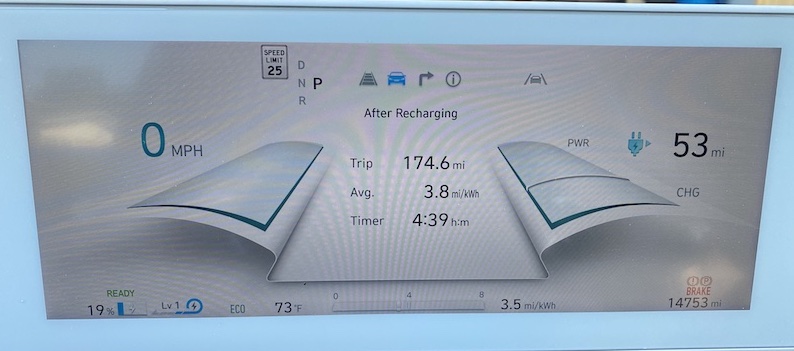It has been a bit over a year and a bit under 15,000 miles since we took delivery of our Hyundai Ioniq 5 so time to play with some numbers.
Usable Battery in kWh
Hyundai advertises the battery as 77.4 kWh but does not say if that is usable or gross capacity. Searching around the web there are some indications that the usable capacity is 74 kWh. But they sell, or at least sold, this car in other markets with an advertised 74 kWh battery so it is possible that the foreign gross capacity and the North American net capacity have been confused by websites. But the car can give quite a bit of information, enough to figure this out.
There is a trip information display that can be set to show statistics since the last recharge. My experience in limited storage on 8 bit processors leads me to be suspicious of accumulation of small values over a long period of time. Too many opportunities to lose precision. And data from short trips will be noisy since a 1% bin on the display will be roughly 2.5 to 2.6 miles based on the published gross battery size and the EPA range. So I only use the values from this display where I have single day mileage that is over 100 miles and preferably over 150 miles. The screen show shows one such session.

In this case we drove 174.6 miles starting with the battery at 80% and finished with 19% and a reported 3.8 Mi/kWh. From the miles and mi/kWh we compute that we used 45.95 kWh. And that represented 80% minus 19% or 61% of the battery. Which implies the usable battery capacity is 75.32 kWh.
This has varied each time I have measured it. Undoubtedly due to errors in measurement, ambient temperatures, and other factors. But taking an average of multiple trips we come up with 73.6 kWh with a standard deviation of 2.6 and a median of 73.0 kWh.
If the 73.6 kWh usable capacity is correct it implies that Hyundai has reserved about 5% of the gross capacity for various reasons.
Charging Efficiency
This one will be even more subject to errors.
When charging there is likely some fixed overhead. That is some electronics in the Ioniq 5 will be on drawing a fixed amount of power. When slow charging this will be a bigger percentage of the power put into the car than with fast charging. But the faster the charging the more energy will be lost to resistance. And the battery cells themselves accept power differently depending on temperature. But we will do the best we can.
Level 2 Charging
Our home EVSE (charger) is set to deliver a maximum of 40 amps at 240 volts (9.6 kW nominal) and is a smart charger that will report the energy delivered in each charging session.
Looking at the average usable battery capacity determined above of 73.6 and that same last trip we probably have to put 44.9 kWh into the battery. Our EVSE’s report for the charging session showed 49.5 kWh. Dividing out that says that charging on that session was just under 91% efficient. Over a number of similar sessions we find we are averaging 85.9% efficiency.
We occasionally charge using a slower 3.8 kW travel charger but it does not report energy delivered so we don’t know how efficient that is. And we have never charged using a Level 1 charger. My guess is they will be less efficient than the 9.6 kW charger simply from a guess of 100 to 200 watts being used by the computers in the Ioniq 5 adding to the fixed overhead.
DC Fast Charging (DCFC)
Electrify America also shows the kWh delivered in a charging session. Running the same analysis on a smaller number of DCFC sessions we find we have averaged 85.9% efficiency.